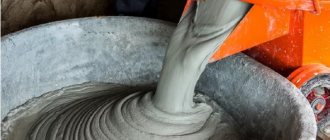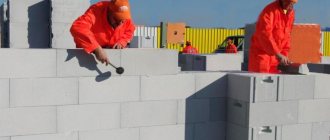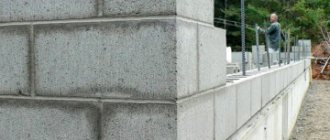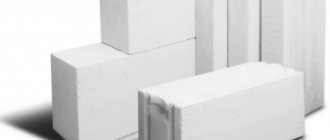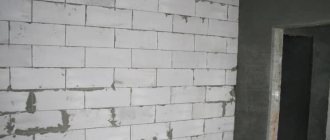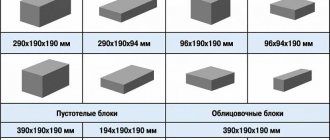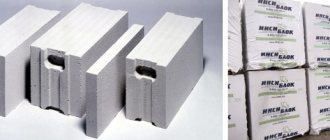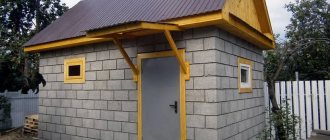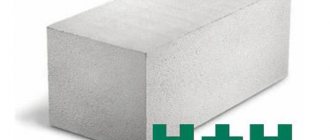At the moment, aerated concrete is the most common wall material, which is why the demand for aerated concrete masonry work is quite high. But it is worth noting that laying aerated concrete is not a very complicated process, yes, there are some nuances, but in general, almost any man who does not have special construction skills can do the laying of blocks.
So, there are three main options for laying aerated concrete blocks:
- Do the masonry yourself.
- Hire individual builders.
- Use the services of construction teams and companies.
Do-it-yourself masonry, at first glance, may seem like the cheapest option, since you won’t need to spend money on the work of third-party people, but on the other hand, people with experience will carry out such work much faster than you, and you would spend this saved time on earning money in your own way. specialties. But everyone’s salary and free time are different, and here everyone decides for themselves.
Application of aerated concrete block
The use of this material in construction is very different from the process of using conventional bricks. Accordingly, it is better to entrust this work to a skilled craftsman. Aerated concrete block is a popular building material on the market, which has an unusual structure that appeared in the process of chemical reactions between aluminum and lime, but also contains cement, sand and other additives. Most often, builders choose this material for several reasons:
- Large block size.
- Economic benefit.
- Accelerated construction process.
Before the laying process itself, it is necessary to take measurements and calculate how many building elements will be required. Workers will need a special mixture to avoid reducing the heat transfer of the material. After preparing all the necessary materials, the builder begins his work, which consists of building rows of aerated concrete blocks. For more precise work, it is customary to use a special cord, which will allow builders to ensure there are no errors.
Technology of laying gas silicate blocks
Gas silicate blocks are used in the construction of both load-bearing walls and internal partitions.
Block Laying Tools
The solution is usually prepared in a plastic bucket using a stirrer on an electric drill. Apply the solution with trowels of different widths. The blocks are leveled in place with a mallet or rubber hammer. Control the position of the block using a building level. If the length of the wall and gas silicate blocks is not a multiple, the entire block is cut into pieces of the required size. To do this, use a marking square, a hacksaw, a plane (or a grater). To lay wires (or pipes), you need a tool for cutting grooves; through holes (and blind holes) are made with drills or crowns. Dust and chips are removed with a soft brush.
To lay gas silicate blocks, use an adhesive mixture or a cement-sand mixture (ratio 1:3)
Laying gas silicate blocks
Before the first layer, it is necessary to make waterproofing. To do this, a layer of roofing material is laid under the first row of blocks using a cement-sand mortar. The solution is also placed on roofing felt. The first row of blocks is placed on this layer.
Cement-sand mortar can also be used when laying blocks, but the seam should not be thicker than 1-2 cm, and if the weather is dry, then the surface of the block is moistened for better adhesion. But it is better to use an adhesive mixture, because... The cement-sand joint gives a large loss of heat.
Laying the first row
Laying the first row must be done with great attention, because this row for the entire wall is a kind of foundation. Begin laying from the corner, aligning the corner blocks along the guides relative to the corners.
After which the blocks are laid tightly next to each other, continuing the horizontal row and taking into account the guides. To ensure that the outer walls are even, stakes are driven along their perimeter in increments of 1.5 - 2 m and string is pulled over them. The guides are used to control the correct placement of blocks horizontally and in bends. The internal partition starts from the side wall. Waterproofing is not done, but markings are made on the walls and floor using a tape measure and level.
Having installed the corner block, apply glue to the side edges of the first (and second) block.
The laid block is checked with a level to ensure correct laying; if necessary, it is leveled with a mallet or rubber hammer. All irregularities are removed with a plane and grater, and debris - dust and small fragments - are carefully swept away with a soft brush.
Glue preparation
Good adhesion of the glue is ensured by a seam of minimal thickness - no more than 2-3 mm, which improves the thermal insulation of the walls. The glue has high strength, and this makes it suitable for laying foam concrete (aerated concrete) and for finishing walls with tiles.
Preparation of glue: Pour water into a plastic bucket, add the dry mixture and stir thoroughly at low speed with an electric drill until smooth. The ratio of dry mixture and water is strictly observed, because This ratio varies from manufacturer to manufacturer.
The quality of the glue is checked on a separate block - glue is applied to it with a notched trowel. If the mixture is easy to apply and the grooves do not merge, then the mixture is correct. The glue that has come out of the seams is removed with the flat side of the trowel, but not rubbed down.
Laying subsequent rows of gas silicate blocks
The second row starts from the corner. If the corner block of the first row lies to the right with the long side, then the block of the second row with the long side should begin the row to the left and vice versa. This alternation gives strength to the structure. Glue is applied to the top surface of the first row, then the first block is placed, and glue is applied to the side surfaces of the first and second blocks.
As the wall grows, check the masonry with a plumb line or laser level. The technology for laying blocks is the same as for conventional bricks, although the robot is much lighter due to the lighter weight of the blocks.
When laying, a smaller block is often needed. Then the standard block is cut with a saw. It is better to use a power saw, because... It is easier to make round, beveled and curved cuts.
Soundproofing properties of walls. The type of masonry can change the heat and sound insulation. A wall made of blocks 50 cm thick gives the same insulation as a wall made of bricks 1 m thick.
Differences in price for work performed
An important issue is the pricing policy for the work performed. The cost of construction services depends primarily on who actually did the work. If the required services were provided by a construction company, the price will be correspondingly higher. And by hiring ordinary craftsmen, you can save a lot on labor costs. The price also depends on the quality of the necessary raw materials used for construction. In the absence of the necessary tools for the job, the price may also rise accordingly.
For greater savings, you can do the construction work on your own, having prepared all the necessary building materials and tools in advance. But it’s better to take on this when you have the specialized skills and knowledge necessary to do the job. Without knowledge of the process technology, the construction result may be of poor quality.
Services for laying gas silicate blocks
All work is performed efficiently and highly professionally. If you are planning to build a house in the Moscow region, then we can offer you favorable terms of cooperation.
Laying gas silicate blocks when building a house is the best option in a region such as the Moscow region. The properties of such blocks are at the highest level. Their use will significantly reduce your construction costs and ensure reliability.
Calculation of the necessary funds for construction from an aerated concrete block
Many factors influence the total cost. It is necessary to select the aerated concrete block itself at an affordable price. Resolve the issue regarding workers' compensation. Calculate all necessary additional consumables.
It is cost-effective to purchase blocks directly from the manufacturer, without intermediaries. On average, the cost of aerated concrete per cubic meter is approximately from 2 to 5 thousand rubles . It all depends on the quality and brand of the block.
Payment for construction labor depends on who the client contacts to complete the work. When hiring ordinary workers, the cost of the order will be approximately 900-1200 rubles per cubic meter. When ordering the services of a construction company, you should expect a price of 1200-1500 rubles per cubic meter.
By paying for the services of a construction company, the client can be sure that his order will be completed with higher quality than that of ordinary covens.
Glue is a mandatory consumable component. To build 1 cubic meter you will need approximately 1 bag of dry glue. The cost of one bag is approximately 180 rubles .
Based on all the obtained values, you can approximately calculate the cost of laying one aerated concrete block - 55 rubles .
Prices
The basic cost of laying gas silicate blocks is 1800 rubles per 1 cubic meter. meter. Find out exact prices by phone.
The modern building materials market offers a wide range of products that allow you to build structures as reliably and efficiently as possible. Our company is a leader in this industry and offers services that include the construction of house walls at competitive prices. Our masons have extensive experience, allowing us to install partitions in the Moscow region in a short time.
Price of masonry for 1 gas silicate block
| Block size (mm) | Volume of 1 gas silicate block (cub.m.) | Number of gas silicate blocks (pcs.) per 1 cubic meter. | Price for laying 1 block |
| 625x 100 x 250 | 0,020 | 50 | 97 |
| 625 x 150 x 250 | 0,013 | 80 | 97 |
| 625 x 200 x 250 | 0,030 | 33,3 | 54 |
| 625 x 250 x 250 | 0,038 | 26,32 | 68 |
| 625 x 250 x 300 | 0,050 | 20 | 90 |
| 625 x 250 x 300 | 0,045 | 22,22 | 81 |
| 625 x 250 x 375 | 0,063 | 16 | 106 |
| 625 x 250 x 400 | 0,063 | 16 | 113 |
| 625x 250 x 500 | 0,080 | 12,5 | 144 |
| 600 x 200 x 300 | 0,036 | 28 | 64 |
| 600 x 200 x 400 | 0,048 | 21 | 86 |
Estimate for building a house
Estimates for the construction of a house made of aerated concrete are drawn up with high frequency during the preparation and submission of design and estimate documentation.
This is often due to the fact that aerated concrete is the optimal material both in terms of installation method and cost. An estimate for the construction of a house made of aerated concrete may contain prices not only for the construction of walls, partitions or other structures from the specified material, but also for other related work. For example, thermal insulation work, waterproofing work, as well as cladding and finishing work can be included in the estimate in form No. 4, local resource estimate, local estimate, etc. The composition of prices in the estimate form must be justified by the set of works in the project or statement object.
Regulatory construction documentation
It will be useful for the developer, before choosing a building material for load-bearing walls and internal partitions, designing a structure, or making masonry from blocks with his own hands, to familiarize himself with the regulatory standards and requirements that are set out in the following documents:
- GOST 25485 - 89 “Cellular concrete. Technical conditions".
- GOST 12852.0 - 77 “Cellular concrete. General requirements for test methods."
- GOST 5742 - 76 “Heat-insulating products made of cellular concrete.”
- SN 277 - 80 "Instructions for the manufacture of products from cellular concrete."
- STO 00044807 – 001 – 2006 “Thermal protection properties of building envelopes”.
- STO 501 – 52 – 01 – 2007 (part I, part II) “Design and construction of enclosing structures of residential and public buildings using cellular concrete in the Russian Federation.”
- SNiP 23 – 01 – 99 “Building climatology”.
- SNiP II - 3 - 79 “Construction heating engineering”. SNiP 23 – 02 – 2003 “Thermal protection of buildings”.
- Manual for SNiP 2.03.01 - 84 “Manual for the design of concrete and reinforced concrete structures made of cellular concrete.”
- Reference manual for SNiP II - 3 - 79 “Calculation and design of building envelopes”.
What does the price depend on?
The difference is quite big, and therefore it is worth figuring out what exactly the price will depend on. There are a number of indicators on which the calculation of the cost of laying cinder blocks per 1 cubic meter will depend. This:
- The cost of the material, that is, the market price of the cinder block. It is worth noting that cinder blocks come in 4 types, differing in size and structure of the blocks, in quality, based on the granulometric composition. The largest number of granules in the structure of the block ensures its high strength and lightness.
- The size of the cinder block directly affects the cost of their installation. The blocks come in 4 sizes: 395x190x190; 390x190x188; 390x120x188; 390x90x188. Dimensions are indicated in millimeters.
- The brand of the building material plays an important role in determining the final cost of the masonry.
- Method of laying cinder blocks: in one stone, in half a stone (in this case, the blocks are cut using a circular or hand saw), in one and a half stones, in two stones.
- The degree of masonry reinforcement.
- The season in which construction takes place.
- The height of the walls being built. The total amount will be affected by the volume of masonry work performed.
As a rule, contractor companies include in the cost of work: laying cinder blocks, mixing cement mortar, installing mesh, and the work of a foreman. The following additional services are provided:
- Linear marking of work performed.
- Depreciation of used means and mechanisms.
- Materials for masonry.
Such services are paid additionally and are not included in the main price.
